With Pakistan Tehreek-i-Insaf (PTI) winning six out of twelve national assembly seats, the 2018 general elections mark the first time since the 2002 polls that any political party has won more seats in the Federally Administered Tribal Areas (FATA), than independently-elected candidates. With a majority mandate in the area, and control of the federal government as well as Khyber-Pakhtunkhwa (KP) provincial government, PTI is now promising a prioritization of FATA’s mainstreaming and merger with KP. To do so it has formed a high level committee for this very purpose. However, while the political mandate remains firmly in place, the difficulty of forming a blueprint for implementation of the merger is becoming clear as all previous reports have only left an extended wish list rather than a realistic plan of how this might be accomplished.
For starters, even now large segments of FATA still feel that they were not adequately consulted before the decision to merge their region with KP was taken. Many fear that they risk becoming a backwater territory of KP and might struggle to get their fair share in public funds. Being part of tribal society offered some advantages that many fear they stand to lose and are skeptical that the benefits of being part of the country’s mainstream setup would reach them any time soon. For example, locals are use to quick justice, very low crime rates compared to adjacent districts of KP, a social safety net system provided by the tribe, (and in some parts by the political administration), and in some manner a more egalitarian system. To create greater buy-in and to try and keep in place positives from the tribal system in place, as the region goes through this historic transition, it is imperative that the merger process and its planning be inclusive. With that in mind it doesn’t bode well that the newly formed committee to look at the merger of FATA, has no representation from FATA. This is especially worrying since the merger basically means rewriting the social contract between FATA residents and the state. Presumption of knowing better than the locals about what’s good for the people of the area on part of the ruling party may prove to be a costly misstep.
In terms of mainstreaming FATA, it is crucial for the government to strike the right balance between developing new institutional infrastructure and reconstruction of homes, basic necessities and other economic infrastructure. For example the Peshawar High Court has estimated that it would require a little under PKR 14 billion to construct judicial complexes in each agency at the district and tehsil level. To put this in context, last year FATA’s total annual development budget was about PKR 24 billion. To further elaborate what this amount means for FATA, consider the fact that the FATA Disaster Management Authority (FDMA) has estimated that over 80,000 homes have either been partially or completely damaged across FATA. According to the government’s policy PKR 160,000 is given to partially damaged homes and PKR 400,000 to completely damaged ones. Disregarding the fact that this amount isn’t even enough to remove the rubble left behind let alone reconstruct compounds housing multiple families, this means that even if each home was partially damaged, the government would need about PKR 13 billion to fund this program. However, so far the government has only been able to commit PKR 5 billion, which goes a long way in explaining its slow implementation.
Some mystifying and ill-thought out specifications for infrastructure development also help explain the large outlay required. For example, in Orakzai Agency where according to the most recent census in 2017, the population is about 250,000, the government is looking to acquire 100 acres of land for making the judicial complex. Why such a large chunk of flat land, in a mountainous area like Orakzai with such a scarce population is needed is incomprehensible. Even judicial complexes in major cities catering to millions of people are nowhere near this size. Similar decisions have been made in other parts of FATA as well.
Spending funds in the right place is one part of the equation, but the reality is that current fund levels in FATA are not enough to reconstruct and develop this war-torn region. Although the previous government of Pakistan Muslim League-Nawaz (PML-N) talked a lot about development funds for FATA, a concrete commitment was never actualized in the end. Initially it was suggested that FATA be given its share in the NFC award which would seem like the logical thing to do but with the provinces not being able to agree to where the share would come from, it was later decided to just earmark PKR 100 billion a year directly by the federal government. However, as mentioned earlier, that too hasn’t come to fruition either.
After a long time one political party i.e. PTI has formed the government at the center as well as in KP and Punjab and as a coalition partner in Balochistan. In Sindh the PPP remains a strong advocate for merging FATA and prioritizing its development needs. In this scenario there is no excuse why FATA won’t be able to get 3 percent in the NFC award for its development needs.
In conclusion, the government needs to be smart in the development decisions they make. For this it’s important for them to do the following:
i) Insure inclusivity and bring on board development and regional experts.
ii) Resist its impulse to acquire large pieces of real estate and develop colonial era institutional compounds that are larger than most towns in FATA, all in the name of developing basic institutional infrastructure.
iii) Commit the funds needed by giving FATA its 3 percent share in the NFC award.
iv) Learn from global examples of leapfrogging stages of development through modern technology. For example, countries like Ghana, caught up with the rest of the world by developing cell phone infrastructure and through it promoted branchless banking directly rather than first developing expensive and outdated traditional phone lines and bank branches.
Ghazan Jamal is the Special Assistant to the Chief Minister for Excise and Taxation, Government of Khyber Pakhtunkhwa. He was formerly an in-country economist at the International Growth Centre (IGC)





